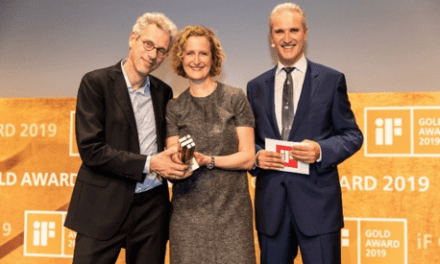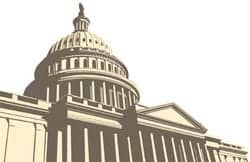
|
The halls of Congress reverberated with the voices of the “Hearing on the Hill,” as advocates of the Hearing Aid Tax Credit bill converged upon Washington on the second Wednesday in May to persuade our nation’s policymakers to enact legislation that would provide financial assistance to the hearing-impaired.
In the House of Representatives, bipartisan bill HR1646, reintroduced in 2009 by cosponsors Rep Carolyn McCarthy (D-NY), and Rep Vern Ehlers (R-Mich), and its companion bill, S1019, brought to the floor of the Senate by Sen Tom Harkin (D-Iowa), would provide a $500 tax credit every 5 years toward the purchase of hearing aids for all adults, and for parents of dependent hearing-impaired children. The more recent Senate version differs from the long-standing House bill in eliminating the previously stipulated age requirement of 55 or older for adults, thus making the credit available to everyone, as well as deleting the $200,000 gross adjusted income cap. With more than 100 cosponsors in the House, and key people starting to sign on in the Senate, the “white hat” bill, as it’s called, is hard not to like, with little vocal opposition on either side of the political aisle.
Which begs the question: Why has it taken the Hearing Aid Tax Credit bill—originally introduced in 2002—so long to pass? And the answer may lie not in who is listening, but more precisely, who is hearing? As Rep Ehlers, himself a hearing aid user, puts it, “It’s easy to persuade people with personal experience with hearing aids. If the House were filled with more hearing aid users, the bill would pass more quickly.”
NOW HEAR THIS
Indeed, there may be more hearing-impaired people in Congress than is readily apparent, as one of the problems in gaining support for the bill is the stigma that is still attached to the wearing of hearing aids, and thus the reluctance of many to admit their need for such devices.
As a remedial step, Jerry Ruzicka, CEO of Starkey Laboratories Inc and chairperson of the Hearing Industries Association (HIA), noted before the meet-and-greet event on the Hill that “part of the proceedings will consist of making hearing tests available to all members of Congress.”
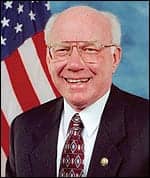
|
| Congressman Vern Ehlers |
Vanity is certainly not the only obstacle, however, nor the primary one. The principal reason for delay in passage of what many think is an obviously necessary piece of legislation ultimately rests at the doorstep where all tax relief bills must gain entrance—the hallowed abode of financial feasibility. “Everything that takes money,” says Ehlers, “is difficult to get passed because there’s never enough money to go to everything that people would like to fund.”
Negotiating the tricky passageways of political influence is the key, says Ehlers. “The legislation process is never simple and straightforward. There’s a lot of jawboning involved in getting enough support to persuade the chairman of a committee to put the bill on the agenda, discuss it in their committee, and eventually report it out.” The impressive number of cosponsors gathered thus far, more than 100 in the House alone, is no guarantee of passage, according to Ehlers. “It’s easy to build cosponsors with a bill like this because it makes a lot of people happy—it’s a white hat bill—but the proof of the pudding is getting it passed.”
As for its current status, Ehlers says, “It’s been introduced and it’s being talked about. The Democrats are in charge this time, but they want Republicans like myself on the bill to show that it’s bipartisan, and they have that. There are people out there excited enough to contact their representatives in government. Letters and calls from constituents are very important. We just have to keep working to build enough support to get it passed. It’s never easy to pass a bill. In life you never get anywhere unless you’re optimistic—that’s also true in Congress.”
His interest fanned by his own experience, Ehlers, 75, says he’s been wearing hearing aids in both ears for the past 7 or 8 years. He notes that he began to have trouble at congressional meetings with echoes that would cause him to miss certain words and points being made. “I don’t have that high a need—my hearing’s not too bad without the hearing aids, but I don’t get the volume. My wife can tell if I’m not wearing them because I turn the TV on too loud.”
He admires the sophisticated technology of the latest models. “This new behind-the-ear model that I have now is great, my hearing is perfect with them.”
It may be that some of the delay in passage of the Hearing Aid Tax Credit bill is caused by simple ignorance. Legislators, as well as the general public, are largely unaware that one of three US adults already suffers from some degree of hearing loss.
According to a recent Reuters report, a study by a team of scientists at Johns Hopkins University revealed that 55 million Americans are believed to have hearing loss in one or both ears, while one out of six, or 29 million adults, have trouble discerning speech, a percentage higher than previous estimates.
Dr Yuri Agrawal of the Johns Hopkins Hospital wrote, “Hearing loss in the United States is predicted to rise significantly due to an aging population and the growing use of personal listening devices. Indeed, there is concern that we may be facing an epidemic of hearing impairment.”
Disavowing or ignoring hearing loss can make matters worse. Reuters reports this can lead to “difficulty in communicating that can result in productivity problems at work, mental depression, and less access to health care that ultimately raises the risk of sickness and death.”
But while hearing loss is common among people 70 and older, it also affects a good number of younger people, 8.5% of those in their 20s and 17% of people in their 30s. Workplace noise, firearms, and loud music were all risk factors.
The bottom line is, hearing loss affects one out of every 10 Americans, but only 23% of the 32 million Americans who would benefit from hearing aids actually use them, and 30% of those with hearing loss cite financial constraints as a core reason for not using them. On average, the cost of hearing aids today is about $1,800 per ear—and an out-of-pocket expense in most cases.
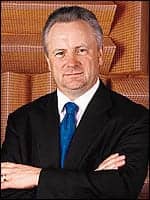
|
| Jerry Ruzicka, CEO of Starkey |
Despite what would appear to be a pervasive and growing problem, hearing aids are not covered by Medicare or most insurers, making the bill all the more imperative, according to its advocates. And yet politicians may not be aware of such exclusions. “Politicians assume that hearing aids are covered by both Medicare and insurance,” says Ruzicka. “But the truth is the United States provides minimal support compared to many European governments, which provide hearing aids for free or have insurance programs that support the principal cost.”
PERFECT STORM
Ruzicka agrees with Ehlers, and just about any veteran of Washington politics, that “the road to getting something enacted is a rough road.” The key, he says, is to find a leading advocate on the powerful committees responsible for pushing any tax-related bill through, to “identify a champion,” as he puts it, on both the House Ways and Means Committee and the Senate Finance Committee. Ruzicka believes that those strong advocates have been found in Rep Chris Van Hollen (D-Md) and Sen Olympia Snowe (R-Me), and that with President Obama’s health care reform initiatives making the issue more visible, “We feel that we now have our opportunity to get the bill enacted.” He adds that the HIA is “actively pursuing a proactive agenda along with many allied organizations.”
A colleague of Ruzicka’s at the HIA, Andrew Bopp, director of government relations, believes the delay in adoption of the bill is typical of any legislation that changes the tax code for all Americans. The bill is “scored” (a term indicating the cost to government), he says, at $300 million per year, or $3 billion for 10 years.
“I’ll grant you, the way government spending has been lately, $3 billion doesn’t sound like an enormous amount, but believe me, it is.” So, even though no one is against it on principle, he thinks it’s not uncommon for legislation like this to take as long as 10 years to enact.
“However,” Bopp says, “we’re optimistic for passage this year because health care reform is on the government agenda, and that reform should be significant. And when significant legislation is considered, that’s when our bill, which is both a health care and a tax bill, is most likely to be considered as part of that legislation. Simply put, this bill will never be considered on its own, it will have to be attached to a larger piece of legislation that includes all sorts of elements for health care reform.”
Bopp, like Ruzicka, notes the importance of having key advocates on the committees of jurisdiction, namely, the House Ways and Means and Senate Finance committees. “All bills that have a tax component must go through these committees. The amount of support on those committees is key. Keep in mind that on average 6,000 bills per year are introduced, but only about 10% of them ever see the light of day. We have to convince Congress that the expense is worthwhile.”
Raising awareness about the degree and importance of the problem is crucial. “What we’ve done,” Bopp reports, “is work with local groups such as the Hearing Loss Association of America and the Alexander Graham Bell Association, to host brunch events for Congressional supporters of the legislation. We just had 180 people in the Philadelphia suburbs for [Democratic Congresswoman] Allyson Schwartz of Pennsylvania, who is a member of the Ways and Means Committee and a key player in health care reform.
“Essentially, what is happening is that this year we’re having a convergence of quite a few committee supporters of health care reform who are becoming more familiar with the hearing health issue. So we’re more optimistic than we’ve been in the past. However, that’s not to say that in the past we’ve failed—everything we’ve done over the last 5 to 6 years has led to where we are now.”
WORKING TOGETHER
All hearing groups, Bopp believes, are working in the same direction because it’s for a societal good. “The cost will be high, but the cost of not doing anything will be higher.”
Another hearing organization spokesperson, Jim Potter, director of government relations and public policy for the American Speech-Language-Hearing Association (ASHA), is pleased that Sen Harkin has introduced the Senate version of the bill, which eliminates the minimum age requirement. “You just have to be a taxpayer or dependent, so essentially everyone can get the tax credit.” He notes as well the elimination of the income cap that was contained in the House bill.
Sen Harkin kindly provided The Hearing Review with a relevant comment: “It’s hard enough to learn that you may need a hearing aid,” he says. “But the one-two punch is then learning how much these devices can cost. The Hearing Aid Assistance Tax Credit Act will provide financial relief to ensure these costs do not stand in the way of allowing people to hear effectively.”
Potter is also pleased that Sen Amy Klobuchar (D-Minn) has signed on as a cosponsor and that the organizations that support her are “gearing up and I think will be doing a ‘Dear Colleague’ next week, which is a letter sent from the office of the primary sponsor of a piece of legislation— Tom Harkin, in this case—to all the other offices in either the House or Senate, requesting their cosponsorship.
“I think what this bill represents is a common ground, politically speaking, on trying to assist those who need a hearing aid,” Potter says. “With the predominance of Americans not having health insurance plans that cover hearing aids, this marks a bill that everyone can get behind, and we continue to build good will and cooperation among advocate groups.”
Like Bopp, Potter sees the dollars involved as the bill’s biggest hurdle to clear.
“The issue with the bill will be the cost impact. Because it’s a tax issue, we’re not really sure what’s going to happen, it depends on the dollars. When all is said and done, it will be a question of how much appetite there is for the expenditure,” he says.
Despite the cautionary note, Potter believes that support continues for the bill in both chambers of Congress, in part because of anticipated increased demand. “One thing we understand,” he says, “is that demand for hearing aids is impacting the workforce—with the Baby Boomers, it’s not just a retiree issue anymore.”
Among the industry leaders actively supporting passage of the bill is hearing aid manufacturer Insound Medical (Newark, Calif), where Susan Whichard, vice-president of marketing, says, “My feeling about the Hearing Aid Tax Credit bill is that it lends credibility to hearing impairment as an important medical issue, and puts the idea in people’s minds that hearing devices are an important health care consideration. It will also help to identify a hugely underserved market—only 20% to 25% of the people who could wear hearing aids actually do so.”
Whichard says the reasons for the gap are clear—price, stigma, and performance. However, regarding the latter, she is quick to add, “Hearing aid companies have worked very hard to improve the technology, which is now excellent, but still haven’t penetrated the larger share of the market, so people don’t know how good the technology has become.”

|
| Former Congressman Jim Ryun |
RYUN’S SONG
Whichard enjoys a unique connection to the issue, as she has worked with Jim Ryun, the former Republican congressman, legendary track athlete, and original sponsor of the 2002 bill. She is pleased that Ryun, who still runs regularly, wears Insound Medical’s “Lyric” model hearing aid, which, she notes, “he can wear while he runs, showers, whatever, because it’s made to wear in the ear continually and to withstand the inner ear environment.”
Regarding the possibility in the future of Medicare and insurance coverage for hearing aids, Whichard says, “I’m less optimistic about getting that kind of coverage because of the huge pressure on insurance companies and Medicare, but I do think the tax credit will begin to get people looking at hearing devices in a different way. It’s difficult to predict if and when insurance coverage will happen, but I think this bill is a good first step.”
Ryun, the last American to hold the world record in the mile run and in 1964 the first high schooler to run the mile in under 4 minutes (he was named by ESPN.com the Greatest American High School Athlete Ever), still runs regularly at age 62, and recalls one way in which he was affected by his own 50% hearing loss, which he said was caused by an attack of measles when he was 5 years old.
“My hearing impairment sometimes affected my balance while running, resulting in my starting to tip over during a race. As time went along, it became clear that the hearing loss was tied to my equilibrium, which was a serious problem for me.”
Ryun didn’t actually begin wearing hearing aids until he was in his 40s and was introduced to the audiology community. “Up until then, though I knew I had a hearing problem while I was growing up, I just tried to make the best of it, positioning myself closer up in classrooms, etc.” For Ryun, finally discovering the advanced technology of better testing and hearing aids in the 1990s was a revelation. “Boy, I’ll never forget the first time I got in the car with hearing aids, I had to turn the radio down, and all of a sudden for the first time I could hear the geese flying overhead during their migration through Kansas.”
Reflecting on the stigma of wearing hearing aids, he recalls that “Although that seems to be a problem with some people, especially men, I just wanted to hear. I didn’t care about the aesthetics or embarrassment at all. For me, it was really a wonderful new adventure to hear better, and another thing was that my wife no longer had to serve as my hearing aid, repeating things for me all the time.”
Having taken note of the seniors in his district who were having trouble handling the expense of hearing aids, Ryun drew up and introduced the first Hearing Aid Tax Credit bill in 2002. “We got cosponsors, but obviously were not successful in getting it passed. What I realize now as time’s gone along, a lot of times a bill will languish for as many as 15 or 20 years before finally getting it passed, but at least we got it started.”
Asked what he thought was the principal obstacle to passage at the time, Ryun replied frankly, “I’d say it was my not understanding that you needed members from the Ways and Means Committee. I started out just getting cosponsors from members that I’d worked with, but you really need to gain cosponsors from the Ways and Means Committee because it’s a tax bill, so they’re the committee of jurisdiction.
“Slowly,” he relates, “after gaining a little bit of support from them, it did get to the point of having a hearing on the bill, but then I was defeated in the election of ’06 [by Democrat Nancy Boyda], and so I had to stop working on it.”
Ryun says the bill, which he had to reintroduce in each new Congress every 2 years, “was very near and dear to me, not just because of my own hearing loss, but also because of a younger generation coming up that’s listening to a lot of loud music and other noises, and I think is going to have some hearing problems in the future.”
Although Ryun has no plans to run for office again, he is still active in the Washington area in speaking engagements and public relations, especially for the hearing industry and for Insound Medical in particular. “Now I just enjoy helping people however I can,” he says.
When told of Rep Ehlers’ remark about the bill passing sooner if more members of Congress wore hearing aids, Ryun returned once again to the stigma theme, saying, “Here’s a little thing, and Vern [Ehlers] may not be free to say this, but there are a number of members of Congress who need hearing aids, and some wear them and don’t want you to see them. So there are more people like that than you know.”
That irksome issue aside, Ryun is very glad that Ehlers and McCarthy, and now Harkin as well, are pressing forward with the bill.
“I continue to advocate for the bill. This is Better Hearing and Speech Month so I’ll probably help with advocacy in some ways, talking to key members on the Hill. I’m a firm believer not only in this bill, but in the fact that we need to prepare for what’s coming, a senior group that is going to continue to grow and bring greater hearing needs along with it.”
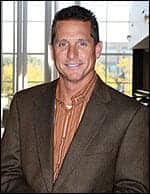
|
| Phonak CEO Mike Orscheln |
PHONAK OUT IN FORCE
Phonak Hearing Systems’ CEO, Mike Orscheln, speaking just prior to his appearance at the “Hearing on the Hill,” notes that his company will have several representatives in attendance, including a number of its sales and education leaders, as well as Cathy Jones, former CEO of Phonak and now executive director of Phonak’s philanthropic Hear the World Foundation.
“First, from a general thought standpoint,” Orscheln says, “it’s a very positive thing to do, if we can get this bill passed. Second, there is pretty broad industry support for this, and third, there’s a whole lot of activity and effort being put into getting congressional support for this bill.
“As far as the agenda for the meeting, we’ll be teamed up with some folks from Insound and Beltone to meet with congresspeople. We have six or seven meetings with them throughout the day, then a hearing test event in the afternoon, followed by a reception in the evening when we’ll share with them our united focus on the hearing-impaired, and why we believe this tax credit is so important because of the financial challenges hearing-impaired individuals can face, given the cost of the sophisticated products that are available today.”
Orscheln comments, in seeming contrast to some of the other advocates, on what he considers a rather unique obstacle to passage of the bill: “It seems a little funny, but one of the obstacles we’ve discussed in our approach to this at the Hearing Industries Association, is that from a budgetary standpoint, the $500 tax credit per year is small compared to the huge sums being spent to revive our economy. So an interesting twist of events is that because it’s a relatively small expense, it hasn’t gotten as much attention as it might deserve.”
Also, he says, another obstacle is that hearing loss is kind of a “hidden” disease. “I’ve been in the health care industry for 28 years, mostly in medical-surgical distribution, and when I was originally contacted by Phonak for a position in their company, I had never even thought of hearing aids as a career; it had never even once crossed my radar screen that there was an industry called ‘hearing aids.’ “
Orscheln certainly has no regrets about his career choice, finding his work in the hearing aid industry extremely fulfilling. “Since then, I’ve learned that it’s a phenomenal industry that can make a huge difference in people’s lives. The purpose of our company is to enrich the lives of the hearing-impaired by providing the best products and services to the hearing health care professionals. So our customers are the audiologists and the hearing instrument specialists, who then fit our products on people with hearing impairment. We’re happy to be known as a technology and service leader in the industry.
“Also,” he concludes, regarding the conference, “listening to the lobbyists and seeing the way that Washington operates is exciting and a great education, very interesting and revealing about how our country works. I mean, voting in elections is one thing, but learning how Congress actually conducts business is just a great opportunity.”

|
| Tom Powers, Siemens Hearing VP |
REINFORCEMENTS
At Siemens Hearing Instruments, Tom Powers, vice president of audiology and compliance, agrees with his peers that “We’ve been trying to get this bill passed for a number of years, but we have a better chance now with the new administration’s emphasis on health care. No doubt this bill will provide some relief for people who need hearing aids.
“Siemens’ role in this campaign,” Powers attests, “is to promote through our own efforts, and by partnering with the BHI (Better Hearing Institute). We have links to the BHI Web site, which provides citizens with a petition in support of this bill that is very simple to sign on to, and that will go to their government representatives at their local level. We’ve seen that letters of that sort definitely bring results. We’re also talking to our customers at our training meetings—we train a couple of thousand hearing professionals yearly on our products and services—educating them on broader market issues such as the tax credit bill, and recommending, if they want to, that they contact their legislators, their federal representatives in their local districts, when they go back home after the training sessions.”
At the Washington conference, says Powers, “We’ll be reinforcing our communication efforts with three of our executives, including myself, convening with legislators, cosponsors and otherwise, to enlist their support. Obviously, there will be other manufacturers there with their representatives as well, and we’ll be cooperating, forming teams to meet with the legislators on a personal level.
“We’ll also be having some industry-sponsored hearing tests in the afternoon to help legislators see that it’s a simple, easy, and, if you will, painless process to test your hearing and identify whether you do have a hearing problem, and learn what to do about it. We hope that this might also go a ways toward fighting the stigma that still seems to be around, about hearing aids being only for older folks, and if you happen to wear one, you might be tabbed as a part of that constituency.”
Other than that, says Powers, “Although I wouldn’t necessarily call it an obstacle, there could be a difference of opinion where some might believe that rather than just providing a tax credit, the Medicare legislation should be changed to go ahead and provide total coverage. Then it becomes a debate about, philosophically, how you think that health care issues should be dealt with.
“In that regard, I’m not sure that we, as a manufacturer, would have a specific position on that since we’re not in policy-making, per se. Either way would be fine, certainly, but this bill is the primary vehicle we have right now, and I think the support is gaining a lot of momentum.”
Powers feels, as do others, that gaining awareness of the issue is the key that will allow more people to come into the hearing aid market, and will help bridge some of the stigma issues attached to wearing hearing aids.
“In the same way that tax credits may have helped the hybrid car industry by making it ‘cool to be green,’ maybe this will help boost the popularity of hearing aids. I don’t know whether it will ever be really cool to wear a hearing aid—I hope it will be—but if we can negate some of that stigma issue by getting more people out there, members of Congress and others, I think it can have a positive effect. Then we can have the second discussion about whether the broader issue of coverage under Medicare makes sense, but I think that’s going to be a very different discussion because of the funding issue and the economy, so that’s probably a debate for another day.”
POSTGAME REPORT
Currently in his second term of leadership at HIA, Starkey CEO Jerry Ruzicka summed up some of the events at the “Hearing on the Hill,” as well as his view of the meeting’s impact.
“There were more than 80 meetings that we had organized with various members of Congress,” Ruzicka reports. “Also, as we made our way through the chambers visiting the legislators, we made them aware that we had a reception that evening (Wednesday, May 13), at which we were offering hearing screenings as one of the activities. We did that so they could get their hearing tested, and also so they could become more familiar with the process and what we do. A number of them did attend and participate in the screening activity. Rep McCarthy and Rep Ehlers, who are very committed to passage of the bill, were both in attendance at the reception.
“Representatives of all of the major manufacturers and component suppliers were there,” says Ruzicka, “and everyone split up into teams of two to conduct our appointments in the House and the Senate.”

|
| It takes less than 5 minutes to write your legislators in an automated process, visit www.hearingaidtaxcredit.org. |
Regarding the outcome of the event, Ruzicka says, “We’re positive about the meetings,” but adds, “As you visit with members of Congress, you find some people who really can resonate with your initiative, and others who, predictably, may not.”
Like his colleagues, he maintains a longrange, optimistic view. “What we’re trying to do is bring exposure to the problem: the fact that one in 10 Americans has some type of hearing problem, and that there generally isn’t any reimbursement for hearing aids.”
But there was no better time to be there, Ruzicka says. “This was the right time for us to be in Washington, because health care reform is the next agenda for Congress. They expect to have legislation drafted by August 1, so the next few months are going to be critical for us to follow up with these members of Congress to ensure that the tax credit gets attached to the health care reform process.”
Given the time and uncertainties involved in gaining passage, it’s hard to know if the Hearing Aid Tax Credit bill will become law anytime soon. But dedicated advocates can feel confident that their cause has been well spoken, and well heard.
Alan Ruskin is staff writer for Hearing Review Products. He can be reached at [email protected].



